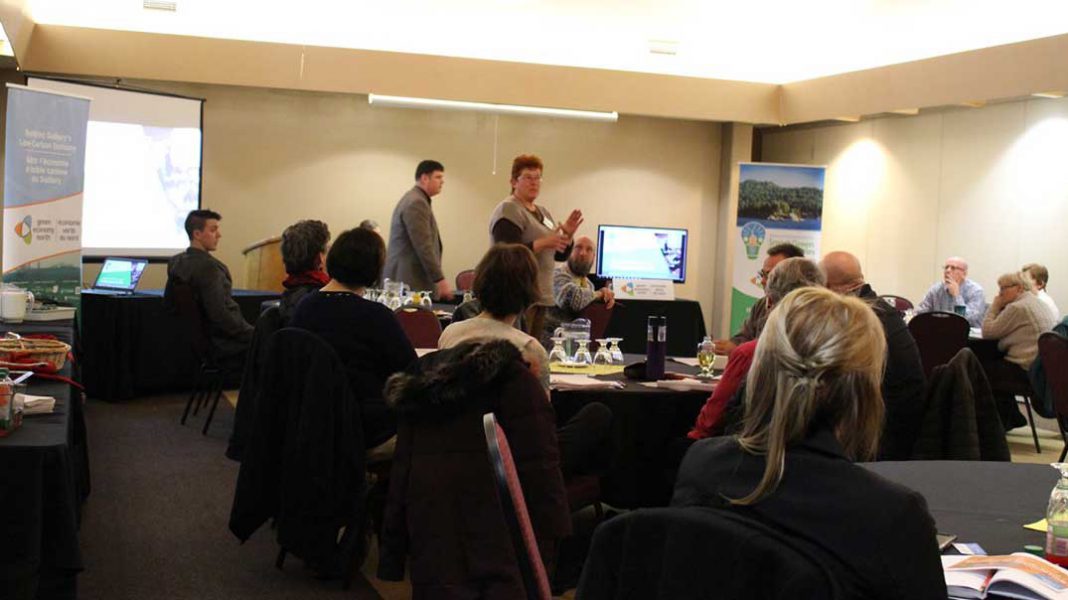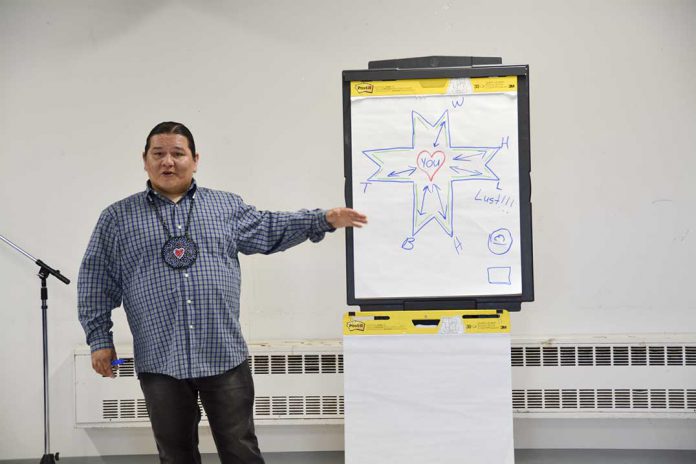LITTLE CURRENT—Sustainability can be a competitive advantage. That is a key message of Green Economy North, a Sudbury-based non-profit organization that works with communities in Northern Ontario. Communities and businesses that reduce their exposure to rising costs in electricity, gas and oil will be in a better position to succeed in the future. To assist small communities to adapt, Green Economy North organized a conference in Little Current called “Building Capacity to Plan,” which focussed on community planning.
Municipalities and First Nations on the Island and the North Shore area are very aware of the high costs of energy and the need to change to mitigate the effects of future price increases. At the conference, community administrative and elected representatives as well as interested citizens gathered to learn about funding opportunities and to find out what progress others have already made.
Keynote speaker Maury O’Neill, CEO of the Wawa Economic Development Corporation, described how Wawa has already started to deal with their issues. Faced with an estimated $6 million per year in electricity use in the community, a declining economy, and water consumption three times the Canadian average, they decided to act about four years ago. They struck a Municipal Energy Committee and initiated a series of consultations, surveys, green educational days, workshops, informational displays, and outreach to youth. With funding from the Trillium Foundation they completed an energy demand study which identified areas of high electrical usage, like the arena, the airport and street lighting. In 2016, Ms. O’Neill’s team helped the city develop an energy plan. Their goals include reducing electricity use in the community by 10 percent by 2025 and water usage by 25 percent.
Wawa has already made progress. They installed five solar panel projects through the microFit program at buildings like the community centre, which will bring in an estimated $54,000 annually, and save on greenhouse gases. They converted street-lighting to LED technology, resulting in a 60 percent reduction in street lighting costs. They replaced the arena dehumidification units, for a saving of 29,653 kwh annually. They promote energy saving programs for businesses and households. They lend out heat guns free, so that businesses and individuals can easily identify the areas of greatest heat loss in their buildings, and they show people how to cover their windows with plastic to reduce heat loss.
Although the microFit program has been discontinued, Ms. O’Neill pointed to a new source of assistance, the Ontario Climate Change Solutions Deployment Corporation, or “green bank,” which will provide significant funding for households, small and medium enterprises and industry in the near future. Funds for the green bank are coming from Ontario’s carbon cap and trade program, which brought in nearly $2 billion to the province last year. This is one of the measures the province has taken to meet their commitment to reduce greenhouse gases to 15 percent below 1990 levels by 2020.
Other resources are also available. Ms. O’Neill said Wawa got a $220,000 grant in 2015 through the Ontario Trillium Foundation’s Grow fund, intended for initiatives they broadly call “Green People,” programs that promote a healthy and sustainable environment. Trillium is holding an all-day workshop on April 17 in Little Current to talk about their Grow Investment stream and Capital Investment streams of funding, and how to apply. Interested people can email otf@otf.ca for more information.
The federal government is also offering assistance. The recently-announced 2018 budget contained several measures to help transition to a green economy, including $416 million over five years for smart grid development, renewable energy technologies and for moving remote communities off diesel. There are accelerated tax deductions for district energy, that is, systems that supply energy efficiently to a block of buildings. The budget also contained tax deductions for combined heat and electricity generation, and wind and solar, which they estimate represents $123 million over the years to 2022-2023. Stay tuned for the Clean Energy for Rural and Remote Communities program, which will include community energy planning as well as biofuel projects. And $58 million is allocated for zero carbon building construction and the adoption of energy efficient equipment.
Jolene Recollet, economic development officer for the Wahnapitae First Nation, said their small community received funding for energy planning from IESO (Ontario’s Independent Electricity System Operator), which manages the electrical power system and plans for future needs. With IESO assistance, approximately 20 First Nations communities have developed energy plans and many more are under development.
Wahnapitae First Nation has an energy planning team which is assessing their Centre of Excellence for roof-top and ground-mount solar panels, and is reviewing home roof tops for their potential, since many houses in the community are south or southeast facing. This is one area that has so far been neglected in most community planning. If new construction is oriented so that solar can be added later, that alone will help in making communities more resilient.
Ms. Recollet also emphasized the importance of sharing information, pointing to a community energy implementation framework that has been developed by QUEST, a non-profit Canada-wide organization that encourages community action on sustainable development.
David Assiniwe, community energy planner for the Wiikwemkoong Development Commission, said they have retrofitted their community buildings to LED lighting, using the savings in electricity bills to pay off the loan for the retrofits. Wiikwemkoong now has 10 solar PV installations, but they are constrained in their ability to produce power because of the limitations of the transmission line connecting Manitoulin to the grid.
These were just some of the potential funding resources and ideas shared at the conference.
Climatologists have been warning for decades that greenhouse gases from fossil fuels are causing global warming at an alarming pace, and that global warming can trigger runaway releases of greenhouse gases through feedback loops like the release of the methane locked in permafrost. Temperatures in the Arctic have already increased by 3.5 degrees Celsius since the beginning of the 20th Century.
At the Paris Conference in 2015, 196 countries set a goal of reducing global warming to no more than 2 degrees Celsius. The goal is global, but reaching it will require action even at the level of small communities.




